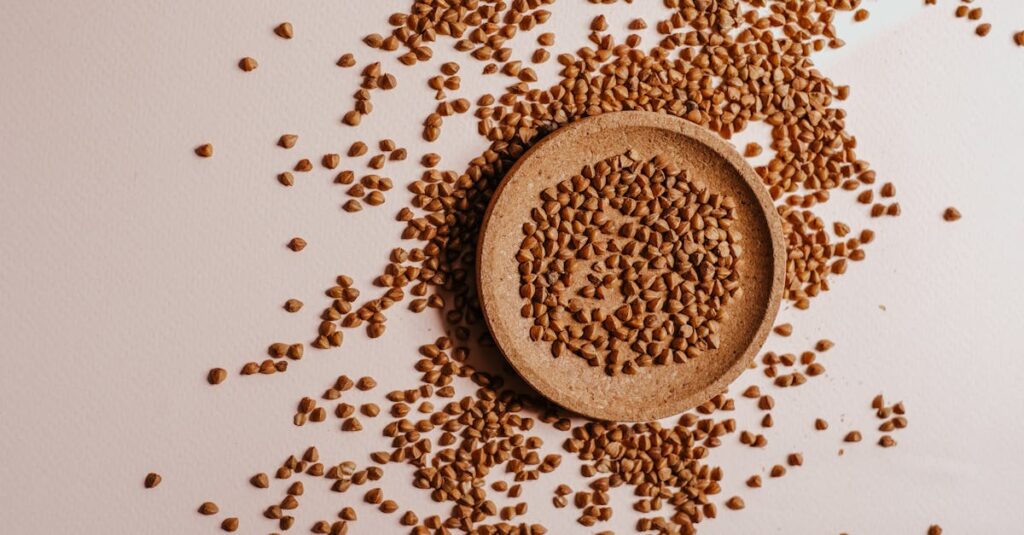Table of Contents
ToggleKasha might sound like a quirky dance move, but it’s actually a culinary gem just waiting to be discovered. This ancient grain, made from roasted buckwheat, packs a punch with its nutty flavor and hearty texture. If you think cooking kasha is as simple as boiling water, think again! There’s a whole world of techniques that can elevate this humble ingredient into a star dish that’ll have your taste buds doing the cha-cha.
Overview of Kasha
Kasha consists of roasted buckwheat groats. This ancient grain boasts a rich nutty flavor and a chewy texture. Nutritionally, it’s packed with protein, fiber, and essential vitamins. Cooks utilize kasha in various dishes, making it versatile for breakfast, lunch, or dinner.
Cooking kasha requires specific techniques to enhance its properties. First, rinsing kasha helps remove any dust or impurities. Following that, toasting the groats in a dry skillet adds depth to the flavor. This step transforms the taste profile significantly, bringing out its distinctive nuttiness.
The water-to-kasha ratio typically ranges from 1.5 to 2 parts liquid for every part kasha. Using vegetable or chicken broth instead of water infuses additional richness into the dish. Boiling the liquid before adding kasha ensures even cooking and optimal texture. Simmering on low heat for about 10 to 15 minutes allows the groats to absorb the liquid fully.
Kasha pairs well with various ingredients. It complements vegetables, meats, and sauces, making it a suitable base for salads or hearty bowls. Many incorporate spices like garlic, onion, or herbs to elevate the flavor further.
Fried kasha can also add an appealing crunch to dishes. Mixing it with eggs creates a delicious breakfast option. Thus, experimenting with kasha opens the door to numerous culinary possibilities, highlighting its ability to adapt to diverse flavors and preparations.
Types of Kasha
Kasha comes in various forms, each offering unique textures and flavors for different culinary applications. Understanding these types helps in selecting the best option for a recipe.
Whole Grain Kasha
Whole grain kasha consists of unprocessed buckwheat groats. This form retains its outer layer, providing a chewier texture and rich flavor. Cooking whole grain kasha generally involves a water-to-kasha ratio of 2:1. It absorbs flavors well, making it an excellent base for savory dishes or warm salads. Nutritionally, it is dense in protein, fiber, and essential minerals, contributing to a balanced diet.
Kasha with Different Grains
Kasha can be combined with various grains, enhancing its versatility. This includes pairing it with quinoa, barley, or rice, each offering distinct textures and flavors. Implementing a mixture of grains often creates a heartier dish, perfect for salads or side dishes. For a delightful contrast, using broken kasha lends a creamier consistency compared to whole grain. Spice blends can amplify flavors, making each preparation unique and delightful.
Essential Cooking Techniques
Kasha preparation involves specific techniques that enhance flavor and texture. Mastering boiling and toasting creates delicious dishes.
Boiling Kasha
Boiling kasha requires attention to the water-to-kasha ratio. For whole grain kasha, a 2:1 ratio ensures optimal texture. Start by rinsing the kasha under cold water to clear away impurities. Next, bring the water or broth to a boil, then add the rinsed kasha. Reduce the heat and cover the pot to simmer for approximately 15 minutes. Fluff the kasha with a fork once it’s cooked, allowing it to cool slightly before serving. This method yields perfectly tender grains that absorb additional flavors from any accompanying ingredients.
Toasting Kasha
Toasting kasha enhances its nutty flavor and adds depth to dishes. Begin by heating a dry skillet over medium heat. Add the kasha and stir frequently for 5 to 7 minutes until the grains become fragrant and slightly golden. This technique brings out a richer taste, ideal for salads or side dishes. Following the toasting step, let the kasha cool before using it in recipes. This process ensures that kasha retains its character while supporting the overall flavor profile of the finished meal.
Flavor Enhancements
Enhancing the flavor of kasha involves the use of various herbs, spices, and ingredient pairings. These additions not only elevate the dish but also complement its nutty characteristics.
Herbs and Spices
Adding herbs and spices can transform kasha into a flavor-packed dish. Some popular choices include thyme, dill, and parsley. Garlic powder or fresh garlic brings out a robust taste when sautéed. Incorporating smoked paprika adds a subtle smokiness that contrasts beautifully with kasha’s earthy flavor. For a touch of heat, crushed red pepper flakes or cayenne pepper works well, creating a delightful balance. Mixing in spices like cumin or coriander introduces an exotic flair, making the kasha more dynamic and exciting.
Pairing Ingredients
Pairing kasha with complementary ingredients enhances its culinary potential. Vegetables such as roasted carrots, sautéed mushrooms, or bell peppers add both color and texture. Combining kasha with proteins like chicken, tofu, or beans increases the nutritional value while creating a satisfying meal. Nuts and seeds, such as walnuts or sunflower seeds, contribute a crunchy contrast, enriching the overall experience. Dried fruits, such as cranberries or apricots, provide a touch of sweetness that balances savory flavors. Lastly, incorporating cheeses like feta or goat cheese introduces creaminess that complements the grains exceptionally well.
Common Mistakes to Avoid
Cooking kasha presents several pitfalls that can affect the final dish. Not rinsing the groats often leads to a gritty texture, as it removes impurities and prevents clumping. Toasting kasha in a skillet should not be overlooked either; doing so deepens its flavor significantly. Many cooks underestimating the importance of the water-to-kasha ratio miss out on the ideal texture, which for whole grain kasha is typically 2:1.
Failing to monitor cooking time can yield mushy or overcooked grains. High heat may seem tempting, but it often results in uneven cooking. Stirring too frequently can also break the grains down, leading to unwanted mushiness. Letting kasha rest after cooking is essential; resting allows the steam to finish the cooking process and improves texture.
Not using flavorful liquids is another common mistake. Cooking with broth instead of water adds depth and richness. Additionally, overlooking seasoning from the start can deprive the dish of essential taste; incorporating herbs and spices early on helps infuse flavors more effectively.
Many forget that kasha pairs well with various ingredients. Combining it with roasted vegetables or proteins enhances nutritional value and flavor complexity. Ignoring the textural elements can limit the excitement of kasha dishes; adding nuts or seeds introduces a satisfying crunch that complements its nuttiness.
Kasha offers a world of culinary possibilities with its unique flavor and texture. By mastering essential cooking techniques like rinsing and toasting, anyone can elevate this ancient grain into a star ingredient. The versatility of kasha allows it to shine in a variety of dishes, whether as a hearty base or a flavorful addition.
Experimenting with herbs, spices, and complementary ingredients can transform kasha into a delightful meal. With its rich nutritional profile and adaptability, kasha is not just a side dish but a key player in healthy and satisfying cooking. Embracing these techniques will surely enhance any kitchen experience.




